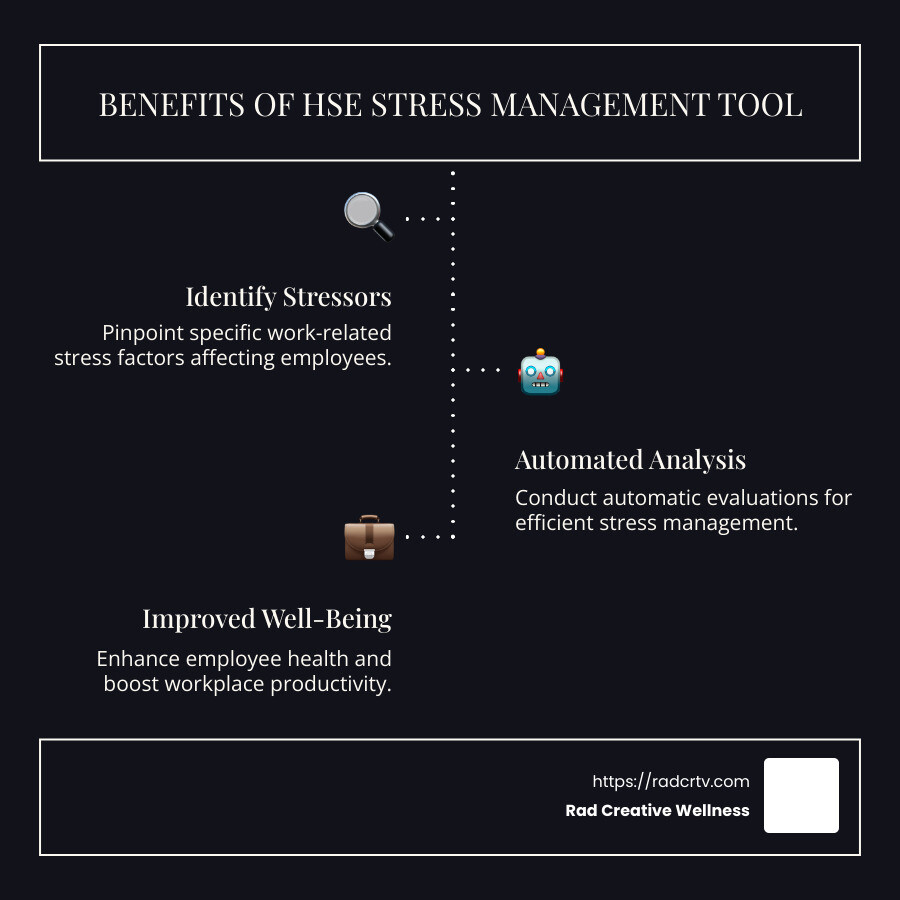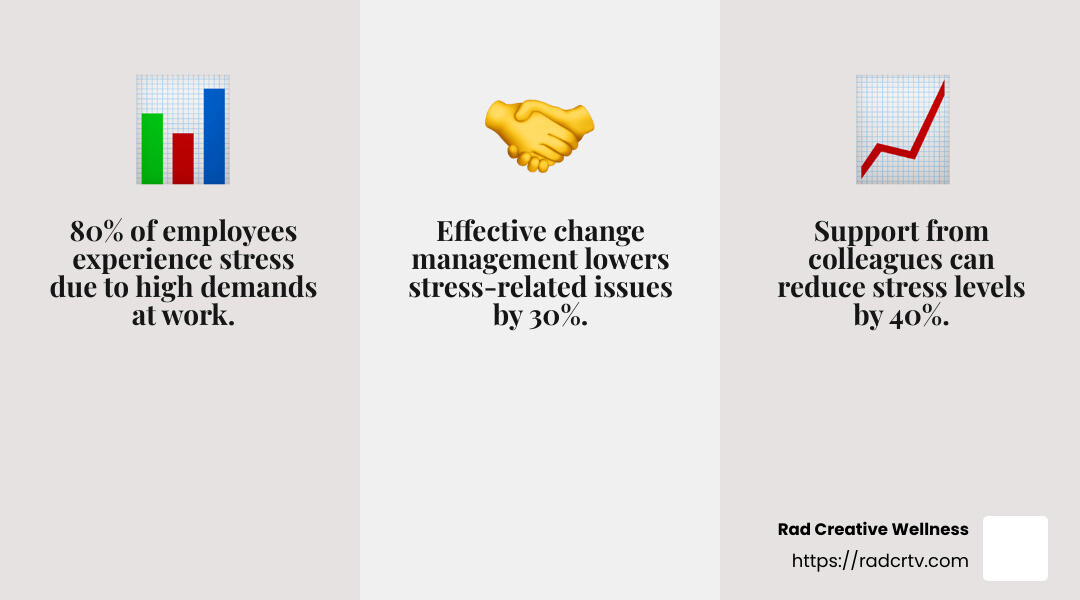
Understanding and Implementing the HSE Stress Management Standards Indicator Tool
|
|
Time to read 10 min
|
|
Time to read 10 min
HSE Stress Management Standards Indicator Tool is a powerful method to identify and manage work-related stress, empowering organizations and individuals to improve workplace well-being. This tool offers free survey and analysis options, vital for recognizing and tackling stressors that can impact employee health and productivity.
In teaming up with tools like the HSE Stress Management Standards Indicator Tool, Radical Creative Wellness aims to reshape how we address workplace stress. By understanding the root causes and implementing strategic interventions, we can improve both individual performance and overall organizational health.
My name is Robert Resz, and with an background in biohacking and wellness, I help professionals steer tools like the hse stress management standards indicator tool. This expertise allows me to empower people to optimize their work environments for better mental and physical well-being.
The HSE Stress Management Standards Indicator Tool is an online survey developed by the Health and Safety Executive (HSE) to help organizations assess and manage workplace stress. This tool is designed to identify stressors that impact employee health and productivity, providing a structured approach to improve workplace well-being.
Purpose: The primary purpose of the tool is to gather anonymous data from employees about their work-related stress experiences. This data helps organizations pinpoint problem areas and develop targeted strategies to address them. With automated reporting features, the tool simplifies data analysis, allowing for clear insights into stress-related issues.
The tool focuses on six primary stressors, which are crucial in understanding workplace stress dynamics:
Demands: This refers to workload, work patterns, and work environment. High demands can lead to stress if not managed properly.
Control: The level of autonomy employees have over their work. More control generally means less stress.
Support: The encouragement, sponsorship, and resources provided by the organization, managers, and colleagues. Adequate support can mitigate stress.
Relationships: Promoting positive working relationships and dealing with unacceptable behavior is key to reducing stress.
Role: Ensuring employees understand their role within the organization helps avoid stress caused by role ambiguity.
Change: How organizational change is managed and communicated can significantly impact stress levels.
These stressors are aligned with the HSE's Management Standards, which aim to reduce work-related stress and improve employee well-being. By using this tool, organizations can benchmark their performance against industry standards, leading to informed decisions and improved health outcomes for their workforce.
The hse stress management standards indicator tool offers a comprehensive approach to tackling stress, making it an essential resource for organizations committed to creating a healthier work environment.
The HSE Stress Management Standards Indicator Tool is more than just a survey; it's a powerful ally in improving workplace wellness. Here's how it can benefit organizations:
One of the standout features of this tool is its ability to provide benchmarking data. By using the tool, organizations can compare their stress management performance against industry standards. This helps identify areas needing improvement and highlights strengths to build upon. As one user noted, "We wanted to baseline stress in the organization using the management standards, and the Stress Indicator Tool was the perfect way to do it."
Automated reporting is another major advantage. The tool generates clear, concise reports that highlight key findings and trends. This feature saves time and ensures that data is presented in an easily digestible format, allowing organizations to quickly act on the insights gained. Users have praised its ability to provide "unbiased opinions from your staff" and deliver "excellent report building and data analysis."
The tool is designed with customisation options to cater to the unique needs of different organizations. Whether it's adding a company logo or tailoring questions to fit specific roles, the tool allows for a personalized approach. This flexibility ensures that the survey resonates with employees and addresses relevant stress factors.
For organizations with diverse workforces, the tool's availability in multiple languages is invaluable. This feature enables employees from various linguistic backgrounds to participate comfortably, ensuring that the data collected is representative of the entire workforce.
In addition to the core functionalities, the tool provides access to exclusive resources. These include guidelines for developing stress management policies and action plans, as well as resources for running focus groups. Such resources are crucial for organizations aiming to foster a supportive work environment and effectively manage stress.
By leveraging these benefits, organizations can proactively manage stress, improve employee well-being, and ultimately improve productivity and morale. The HSE Stress Management Standards Indicator Tool is not just about identifying stressors; it's about empowering organizations to create lasting positive change.
Implementing the HSE Stress Management Standards Indicator Tool is a straightforward process that can significantly improve workplace wellness. Follow this step-by-step guide to get started:
1. Survey Setup
Begin by setting up the survey. This involves customizing the tool to reflect your organization’s unique needs. You can add your company logo, adjust questions to fit specific roles, and choose the languages required for your workforce.
2. Data Collection
Once the survey is set up, distribute it to employees. Ensure anonymity to encourage honest responses. The tool supports online distribution, making it easy for employees to participate via their preferred devices. Clear communication about the survey’s purpose and confidentiality is crucial to maximizing participation rates.
3. Analysis
After collecting the data, the tool’s automated analysis capabilities kick in. It processes the responses and highlights key trends and areas of concern. This feature saves time and ensures accuracy, providing a clear picture of the stress levels and stressors affecting your organization.
4. Reporting
The tool generates comprehensive summary reports, presenting the findings in an accessible format. These reports include recommendations for addressing identified stressors, enabling you to plan targeted interventions. Users have praised the tool for its "excellent report building and data analysis," which helps in making informed decisions.
Communicate Clearly: Keep employees informed about the survey’s purpose and how the results will be used. This transparency builds trust and encourages participation.
Follow-Up: After analyzing the data, consider holding listening circles or focus groups to gather qualitative insights. This approach can provide deeper context to the survey findings.
Take Action: Use the recommendations provided in the reports to develop and implement action plans. Regularly review and update these plans to ensure they remain effective.
By following these steps, you can effectively implement the HSE Stress Management Standards Indicator Tool and take meaningful steps toward improving workplace wellness. This process not only identifies stressors but also empowers organizations to foster a supportive and productive work environment.
The HSE Stress Management Standards Indicator Tool is a powerful resource for understanding and managing workplace stress. Here are some of its key features:
The tool is designed as an online survey, making it accessible and easy to distribute. Employees can complete it on their preferred devices, whether they're at the office or working remotely. This flexibility encourages higher participation rates and ensures a broad range of feedback.
Anonymity is a crucial aspect of the tool. Employees can provide honest feedback without fear of repercussions, which leads to more accurate and reliable data. This feature is essential for identifying genuine stressors within the workplace.
One of the standout features is the automated analysis. Once the survey data is collected, the tool automatically processes the responses. This not only saves time but also reduces the risk of human error in data handling. The automated system highlights key trends and areas of concern, giving you a clear snapshot of workplace stress levels.
The tool generates detailed summary reports that are easy to understand. These reports present the findings in a concise format, making it simple for management to grasp the situation at a glance. The reports are praised for their clarity and effectiveness in illustrating the stress landscape within the organization.
Based on the survey results, the tool offers recommendations for addressing identified stressors. These actionable insights help organizations develop targeted interventions to improve employee well-being. By following these suggestions, companies can create a healthier, more supportive work environment.
By leveraging these features, the HSE Stress Management Standards Indicator Tool empowers organizations to take proactive steps in managing stress. This not only improves employee well-being but also boosts overall productivity and morale.
In today's evolving work landscape, many employees are spending part or all of their work time at home. This shift brings unique challenges and stressors that the HSE Stress Management Standards Indicator Tool addresses through its Home and Hybrid Working Tool.
The Home and Hybrid Working Tool includes additional questions custom to the specific needs of remote and hybrid workers. These questions are designed to assess how modern working practices can impact stress, anxiety, and depression. The aim is to capture the nuances of working from home, which can differ significantly from traditional office work.
Remote work can blur the lines between professional and personal life, leading to increased levels of stress, anxiety, and even depression. The tool helps identify these issues by focusing on factors such as workload management, work/home interface, and the level of support from peers and management.
The tool's development was informed by rigorous research conducted by the University of Hull, involving nearly 300 hybrid workers in various roles. This research provided valuable insights into the stress risks associated with home and hybrid working, ensuring that the tool is grounded in real-world data.
With the rise of flexible work arrangements, it's crucial to understand how these practices affect employee well-being. The tool helps organizations adapt to modern working environments by highlighting stressors specific to remote and hybrid settings. This information is vital for creating effective strategies to improve employee health and productivity.
The Home and Hybrid Working Tool is an essential addition for any organization navigating the complexities of modern work arrangements. By addressing the unique challenges of remote and hybrid work, it supports a healthier and more balanced work-life experience for employees.
The HSE Management Standards Indicator Tool is a comprehensive 35-item questionnaire designed to assess workplace stress levels. It focuses on six primary stressors that can affect employees' well-being: Demands, Control, Support, Relationships, Role, and Change. These stressors are crucial in evaluating work design and understanding how they impact health outcomes.
The tool is widely used to gather data on how these stressors manifest in an organization. It helps identify areas where stress levels are high, enabling businesses to take targeted action to improve employee well-being.
The Stress Indicator Tool is an online survey that identifies workplace stressors. It aligns with the HSE Stress Management Standards and provides organizations with the information needed to plan improvements. By collecting data from employees, it offers insights into how stress affects their daily work life.
This tool generates automated reports that highlight key areas requiring attention. It allows organizations to benchmark their performance against industry standards and customize their approach to managing stress. The insights gained can be used to develop strategies to improve workplace conditions and improve employee satisfaction.
One widely recognized tool for measuring psychological stress is the Perceived Stress Scale (PSS-10). This scale assesses the degree to which situations in a person's life are appraised as stressful. It is different from the HSE tools, as it primarily focuses on individual perceptions of stress rather than workplace-specific stressors.
The PSS-10 is often used in conjunction with other tools, like the HSE Management Standards Indicator Tool, to provide a more comprehensive view of stress levels. By understanding both individual and organizational stress factors, companies can implement more effective stress management solutions.
In today's world, managing stress is more important than ever. The HSE Stress Management Standards Indicator Tool offers a practical way to assess and address workplace stress. By focusing on key stressors like Demands, Control, Support, Relationships, Role, and Change, organizations can identify problem areas and take action to improve employee well-being.
At Rad Creative Wellness, we believe in the power of blending creativity with scientific wellness practices. Using tools like the HSE Stress Management Standards Indicator Tool aligns perfectly with our mission to empower individuals and organizations to improve their health and well-being. By integrating these insights, we can foster environments where employees thrive, reducing stress and boosting productivity.
Stress management isn't just a nice-to-have; it's essential for a healthy and productive workforce. By understanding and implementing effective stress management practices, we can create workplaces that support mental and emotional well-being. This not only benefits employees but also contributes to the overall success of the organization.
Explore our range of wellness solutions and find how we can help you transform your approach to stress management. Visit Rad Creative Wellness to learn more.
Incorporating stress management tools into your wellness strategy is a step toward a healthier, more balanced life. Let's work together to make stress a thing of the past and well-being a priority for everyone.


